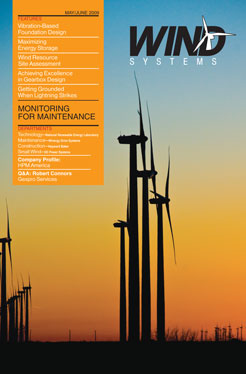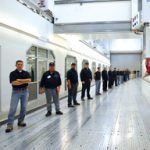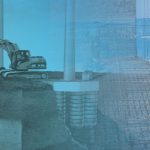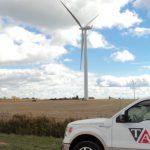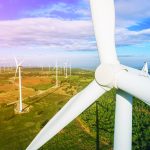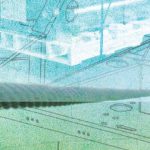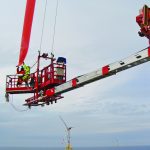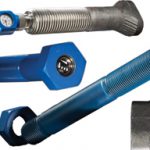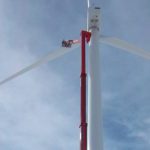It’s been said that when one door closes, another often opens, and the smart businessperson is constantly searching for that first light of opportunity to shine through the crack. Such was the case nearly three years ago, when a major wind turbine OEM was looking for a source to machine its hubs and contacted HPM America, according to Gerard Sposato, the company’s vice president of sales and marketing.
“Since around 2001 U.S. die casting has really slowed down,” he says, “going from some 3,000 companies in North America to about 300, and dealing with automotive companies and suppliers has led injection molding to experience the same downturn as well. A lot of that has to do with outsourcing the work to other countries, but it’s also because of the changing structure and needs of the automotive industry based upon the current economic downturn. So when we were contacted by this OEM we realized that we had the ability, the people, the equipment, and the infrastructure in place to perform this work, so we decided to diversify our product offering and enter the wind-power energy market, and it’s ended up being a perfect fit. Wind has really turned this company around.”
Serendipity has long played a role in this company’s history, beginning with its founding in 1877 when Augustus Q. Tucker—an owner of apple orchards around Edison, Ohio, who was also a student of mechanical engineering—developed a hydraulic press for making cider. Such were the beginnings of the Hydraulic Press Manufacturing Co., or HPM, which also developed the first American-made injection molding machine in 1931. Today the company is headquartered in Mount Gilead, Ohio, with three additional locations in Brazil and India.
According to Sposato, HPM America has two business segments: an OEM side, which manufactures injection molding, die-cast, extrusion, and hydraulic press equipment; and its contract manufacturing operations, which includes its machining capabilities for wind and other industries, such as mining. These activities are conducted in a 400,000 square-foot facility so vast that it has its own rail spur entering an assembly bay, and it’s also able to utilize its own in-house heavy haul trucking group, resulting in the ability to ship directly and economically to any site in North America.
“We offer single-source responsibility to our customers,” he explains. “On the contract manufacturing side we can purchase castings and steel directly from the foundries and truck them here to our facility, machine the castings and fabricate parts, assemble them if necessary, and then paint the completed machine parts in one of our four down-draft paint booths. We can then check the part in our state of the art inspection station and ship the order to a destination of the customer’s choosing, either by road or rail. We feel that’s a pretty powerful package.”
And a package that helps keep costs down, he adds, since any time a process can be completed in-house the price of shipping to a subcontractor is saved. “Every time you send a part somewhere it can cost you two- or three-thousand dollars, depending on the part size and weight, so we try to do everything that we can right here at HPM. We can do as much or as little as a customer wants, depending on their needs.”
The same is true for its OEM capabilities, where many clients call for a turnkey package, contracting with HPM to build the machine, ship it to the customer’s facility, and install it using its own highly experienced personnel. The company also keeps an extensive inventory of spare parts on hand—about a million at any one time—and on the contract manufacturing side it keeps full inspection reports on file for 20 years, all of which can be accessed by the customer online, should they need them. “We do all of this because we’re not taking a ‘hit and run’ approach to sales,” Sposato says, “we want to partner with our clients for a long, long time. It’s often easiest to make that first sale, but the second, third, and fourth one is harder. But if you can’t perform on the first one, you won’t get the chance to work on the others.”
As for its wind-specific activities, HPM’s Contract Manufacturing Unit can produce a number of parts for the nacelle, including the hub, bases, front support, generator frames, and pitch plates, among many other component parts. The company has a full engineering staff in the States as well as in India, and those services can be contracted on a stand-alone basis. “We’ve worked with a number of companies on that basis globally,” Sposato says, “where they’ll contract our engineers to complete a project at either our facility in Ohio or in India, or we will send an engineer directly to the client’s location to perform the work, whichever scenario is best for them.”
At a time when the wind-power industry is gaining substantial traction in the United States, HPM America is poised to play a prominent role in its continued development, offering a singular slate of capabilities to its current and potential customers. “We want to be the company that people can count on. Our goal is to exceed our customer’s expectations in terms of quality and delivery, and we also want to be an environmentally conscious member of our community and world,” he says. “We want to set the benchmark that other manufacturing operations are held to.”
Call (419) 946-0222, send e-mail to sales@hpmamerica.com, or go online to www.hpmamerica.com.



















